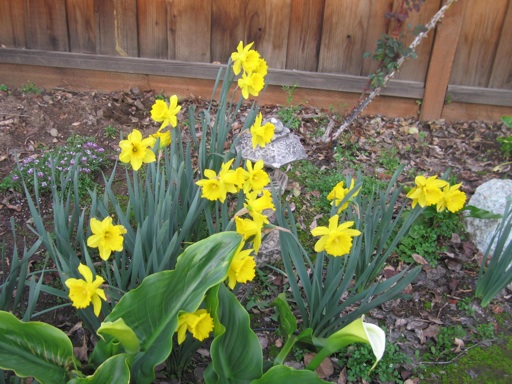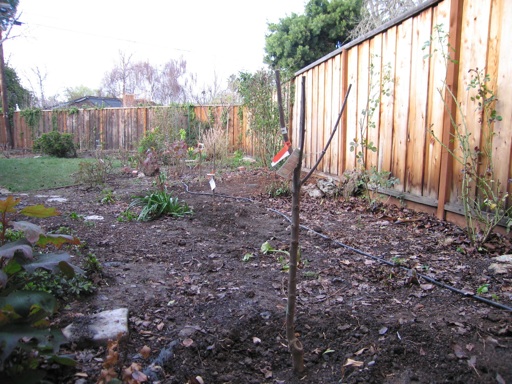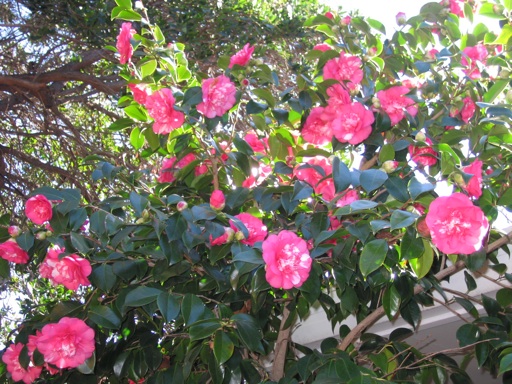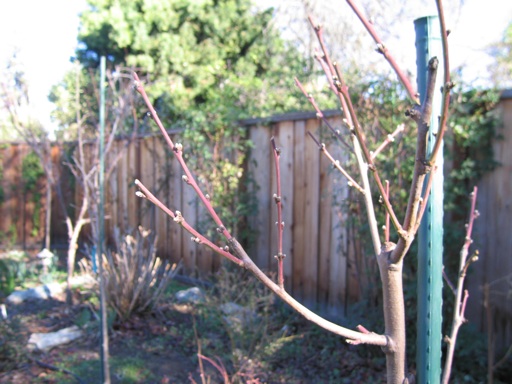
The daffodils I planted back in the fall of 2007 started to bloom again more than two weeks ago, and they are continuing to hold on to their color and shape. Daffodils are the first plants to start blooming in our yard this year. Nearly everything else is dormant. The yard looks relatively bare (see picture in my last post) so it’s nice to have some early spring color to look at.
Daffodils seem to require virtually no care in our climate. They usually get plenty of rain water in the winter as they are sprouting back to life. By the time the dry season begins in April, daffodils die back to the ground. They don’t seem to require watering while they are dormant. I didn’t water them very often last spring and summer. We received no rain from March through September, but despite the lack of rain, they came back to bloom again for a second time.
Also, daffodils don’t require a large amount of winter cold to bloom year after year like tulips and other types of spring flowering bulbs. We don’t get very much freezing weather here.
A few years ago, I made the mistake of planting daffodils under an eve of the house where they did not receive any rain water. Those daffodils grew back the next year, but they did not bloom. After a few more years, they died. I figured they died because they were not getting any water. I often see daffodils blooming alongside the freeway, so I guessed that they must be low maintenance plants. So I decided to plant more daffodils away from the house where they would receive rain. These are the daffodils in the picture.
February 28 2009 | Daffodils | Comments Off on Daffodil Blooms Signal Spring is Near

I am nuts about fruit trees! Last weekend, I spent time planting a few new fruit trees in our yard. I planted a Bing cherry, a Rainier cherry, and a Royal Rainier cherry. I also transplanted our small young apple trees and one small pear tree closer together to make room for the cherries. Yesterday, I planted an almond tree. We now have 3 apple trees, 4 cherry trees, 4 pear trees, one yellow peach tree, one white nectarine tree, 2 apricot trees, 1 fig tree, and 1 almond tree. We also have 3 orange bushes and a lemon bush.
Traditional orchards plant fruit trees 15-20 feet apart, because they grow so large when they are minimally pruned. Many publications also recommend that fruit trees in backyard orchards be spaced 15-20 feet apart. The problem is that our yard is only large enough to support about 4 or 5 trees at 20 feet apart and a large distance from the house and fence. Our lot is about 1/5 of an acre.
I have planted most of our fruit trees about nine feet apart. That’s much closer than most traditional orchardists would recommend. However, there has been a growing movement to plant fruit trees closer together in high density plantings. The idea is to plant many more different kinds of fruit trees close together in a smaller area to achieve a larger variety and a longer season of fresh backyard fruit. If the proper varieties are selected, a backyard fruit orchard can produce freshly ripened fruit from May through November. For example, one can plant early season ripening, mid-season ripening, and late season ripening peaches in one yard to get peach harvests from May through September.
In order make a high density fruit orchard manageable, the grower should be committed to size control. Some fruit trees are sold on dwarf rootstocks, but many varieties are not. Most of our fruit trees are grafted onto semi-dwarf rootstocks that will allow the trees to grow to 15-25 feet tall (or larger) and as wide. That’s far too large for a high density backyard planting. Fruit trees planted in high densities need to be keep small (e.g., 6-8 feet tall and wide) so that the branches do not grow together and shade each other.
I have recently read that the key to keeping fruit trees small is to prune them once in the spring (May) and again in the summer time (July-Sept.). Traditionally, fruit trees are pruned only during the dormant season in the winter time. However, if that technique is applied to a high density planting, the fruit trees will grow large root systems during each growing season. Then, if the trees are severely pruned during the winter months to control their size, they will grow back very vigorously during the next growing season, making it difficult to keep them small and manageable.
I have read that spring and summer pruning will keep the root system from storing too much food during the growing season, which will keep the tree from growing too vigorously during the next growing season. I have not tried the summer pruning technique yet, but I plan to start this year to maintain our trees at a height of no taller than about 7-8 feet. We have a few fruit trees that have already grown much larger than that, including a pear and a cherry. I may prune them gradually over a period of a few years to bring their size down.
I have found that large fruit trees (i.e., taller than about 8 feet) are difficult to manage. I have to put netting on many of our trees (even the apples) to keep squirrels from eating all of the fruit. It’s just not practical to net a large tree. Also, it’s difficult to harvest fruit from the top branches of a large tree. Cherries are especially difficult to harvest from tall branches, because the fruit is so small that it cannot be easily picked using a long pole with a wire basket at the end. And looking up for a long time while picking fruit can make one’s neck sore. At this point, I am convinced that growing fruit trees as large shrubs, rather than large trees, is the way to go.
Dave Wilson nursery is one of the suppliers of fruit trees that is promoting high density plantings. See e.g., http://www.davewilson.com/homegrown/BOC_explained.html. They recommend planting 3 or 4 trees in one hole at 18-24 inches apart or planting a hedge row of fruit trees 3 feet apart in the row. That seems a bit too close for my tastes right now, because I want to have room to walk between the trees. So I settled on a nine foot spacing, because that left just enough room to allow my current trees to fit into the available space along the back fence, about 6-7 feet from the fence.
However, I am still contemplating the possibility of buying more types of trees, possibly an early or late ripening peach! If that happens, I may have to cram a few of them in a little tighter. 😉
February 15 2009 | Fruit | Comments Off on High Density Fruit Tree Plantings

There’s not much going on in our yard right now. Most of our perennials are deciduous and are currently in their dormant phase. The only plants that are in full bloom in our yard are the camellias. This picture shows the Faith Variegated camellia bush that is blooming outside our bedroom window. Every year it fills up with pink flowers from January through March. They are beautiful flowers, although they don’t have any detectable fragrance.
Camellias tend to be a bit messy during bloom time. The flowers fall off the bush completely intact before they wilt or turn brown. They don’t fall apart petal by petal like roses. After a few weeks of blooms, the ground underneath the bush is full of pink flowers. Also, camellias don’t make great cut flowers, in my opinion, because they tend to fall off the stem in just a few days. Yet, despite the mess, they are one of my favorite garden plants, because their flowers and leaves are so attractive and eye catching.
February 07 2009 | Camellias | Comments Off on More Faith Camellias

On Friday, I sprayed my peach and nectarine trees to control peach leaf curl. I also sprayed them in late December. I have been spraying my peach tree twice each winter while the tree is dormant since I planted it back in 2002.
I have heard people coming into our local nursery complaining about peach leaf curl in the spring. Unfortunately, it is too late to spray then. The spray needs to be applied at least once while the tree is dormant. I typically spray twice. In very wet years, I spray three times.
Now is the time to spray peach and nectarine trees to control the leaf curl fungus. I have read that the most important time to spray is just as the buds are beginning to swell, and before the blossoms open up. With all of the warm weather we have been having in the past month (today the high temperate neared 70 degrees again), the buds on my white nectarine tree are staring to swell (see above picture). I expect it to bloom before the end of February.
February 01 2009 | Peaches/Nectarines | Comments Off on Spraying Peach/Nectarine Trees to Prevent Leaf Curl



